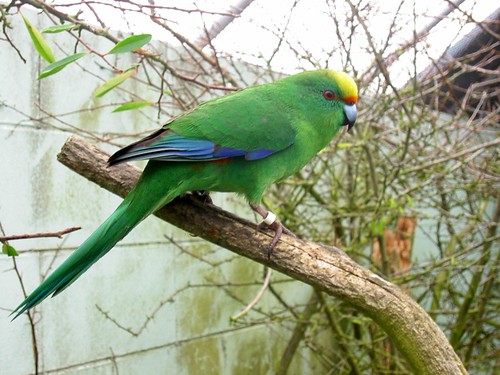 Cyanoramphus malherbi, a "nationally critical" rare endemic bird of New Zealand. This is one of several birds being bred in captivity at Isaac Peacock Springs wildlife refuge. Image by Jon SullivanThe transfer to Blumine Island of birds deemed nationally critical with a high risk of extinction is imperative before a plague of predators gobbles their eggs.
Cyanoramphus malherbi, a "nationally critical" rare endemic bird of New Zealand. This is one of several birds being bred in captivity at Isaac Peacock Springs wildlife refuge. Image by Jon SullivanThe transfer to Blumine Island of birds deemed nationally critical with a high risk of extinction is imperative before a plague of predators gobbles their eggs.
Department of Conservation staff shifted 21 orange-fronted kakariki from a private breeder's residence in Peacock Springs, Canterbury, to a reserve on Blumine Island, Queen Charlotte Sound, to help ensure the survival of New Zealand's most endangered parakeet on Wednesday last week.
It is believed a good warm winter, like that experienced last year, caused trees to create more seeds than usual in autumn.
This larger food source encouraged mice to breed, sparking an increasing number of stoats which feast on them.
Both animals love to eat kakariki eggs.
Plagues of pests occur randomly because it is too difficult to predict when a warm winter will occur.
Department of Conservation programme manager for biodiversity in the Marlborough Sounds Mike Aviss said although the process remained largely mysterious, he expected a swell in the number of predators over the next three months.
"The best thing we can do is protect from the plagues. That's why they're endangered, because of the huge plagues of predators building up every few years."
The transfer was the third batch of orange-fronted kakariki, flown up in little timber boxes, to be safe-housed at the Blumine Island Reserve since December last year and brings the total number living on the island to 54.
The beech forest-dwelling birds are prolific breeders, able to reproduce at any time of the year, and the first report on their progress will be conducted in winter.
The birds had also been placed on predator-free Chalky Island in Fiordland, Maud Island in the Marlborough Sounds, and Tuhua Island near Tauranga, and all had started breeding shortly after their release.
"A good release means they all come out chirping and fly off strong.
"As long as they keep on producing the chicks down there in captivity, we'll keep receiving chicks and releasing them on the island."